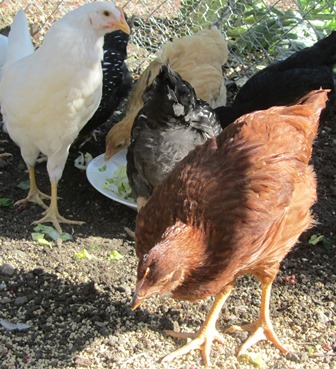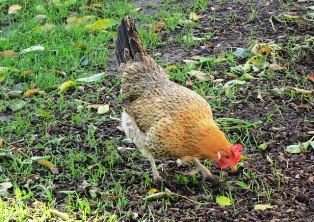Buffo’s Gone Broody
My Buff Orpington hen won’t leave the nest. I’ve taken to putting out a bowl of crumbles and a canister of water so she’ll have nourishment while she sits on a a pile of eggs.
I’m beginning to think that with her this broody period is going to happen about every six months–at least that’s been the case so far.
Ruby the Rhode Island Red, the Wyandotte sisters, the Black Sex Link, and my two white leghorns are being de-laned into the two other boxes. And I have to practically crawl into the chicken house to reach the last nest box to retrieve their eggs.
Our town doesn’t permit us to keep roosters. Ergo, those eggs that Buffo is trying to hatch will have to be tossed at the end of her broody period. They’re not fertile and will never hatch. But I haven’t the heart to tell her.
* * *
If you enjoy reading about farmette life, check out my cozy mystery novel series from Kensington Publishing, New York. The books feature a farmette milieu, farm sayings, tips, and facts as well as delicious recipes to try. The books are available from online sources such as Amazon, Barnes & Noble, Walmart and others as well as traditional bookstores everywhere.
Why You Should Never Leave the Farmhouse Door Open
I unlatched the hen house door to let the birds out for the day. Then I filled water basins for my chickens, honeybees, and farmette wildlife. Finally, with chores done, I returned to the farmhouse to work on my new book.
Lost in a tense winter scene for novel number three, I wrote until I heard the chickens cackling as they do when they lay an egg or are frustrated because they can’t get the nesting box already occupied by another hen. And of late, that happens often because one of my Wyandotte chickens has gone broody. She’s sitting on two dozen eggs and it’s futile since we don’t have a rooster. Those eggs will never hatch.
As the cackle grew louder. I stopped typing to peer out the window next to my desk. Nothing seemed out of the ordinary, but on the off chance that a skunk, fox, chicken hawk, or other predator had invaded the yard or the hen house, I got up. I had to check.
By now the cackle had become deafening. I thought the chicken might be at the back door. As I turned from my computer to walk down the hall past my bedroom, I saw my Rhode Island Red directly in my path. Her cackle could wake the dead. So why was she making such a ruckus.
Then I saw it–a dollop of chicken poop on my new hardwood floor. She must have known I’d be furious. And she’d been trying to tell me something. I swooped her up and carried her outside, making a mental note to always check the door on the farmhouse. My office is no place for a chicken.
If Your Chickens Aren’t Cold Hardy, What Can You Do?
Chickens that can tolerate extreme cold are considered cold-hardy. The Dominique, Hamburg, Langshan, Sussex, and Wyandotte breeds are considered chill tolerant (even cold-hardy) but breeds such as Crevecoeur and Catalana are less tolerant of temperature extremes. So are Bantams and some breeds with large, single combs.
The chickens generate body heat that helps alleviate the cold temperature of a coop. They also wear feathered coats and will huddle together for warmth. A hen house that has insulation and perhaps a south-facing window that captures the warmth of a winter sun can also mitigate extreme cold.
Still, if you live in an area where the temps are below freezing, where it snows, and where the wind contributes to the chill, you might want to hang an ordinary light bulb (40-60 watts) or a 50-watt red bulb if you worry about frost-bitten chickens on those coldest nights.
Put that lamp on a timer. But beware of hanging any electric light that could get knocked down. It could set your coop on fire. And cold-tolerant breeds probably don’t need the extra heat anyway.
Perhaps equally, if not more, important are the chickens’ need for fresh water, ventilation, and a dry environment during winter. You don’t want the chickens roosting in a draft, but you do need ventilation in the coop, for example, via egg-access doors, windows, or ventilation holes with screens. They also need a dry environment.
If the coop isn’t insulated, you might stack bales of straw or hay along the walls and scatter pine shavings if your coop has an earthen floor that becomes cold or frozen.

This chicken house has egg access doors, a human door, a window, and is insulated; the art is optional.
Cold-hardy chickens probably will make it through most frosty nights with few to no problems. Your best tool is your ability to observe your chickens for problems. Oh, and you might want to place a thermometer inside the coop for an accurate measurement about how cold it really gets when the ladies (and rooster, too) are all inside.
Don’t judge your chickens’ endurance for cold by your own.
 Facebook
Facebook Goodreads
Goodreads LinkedIn
LinkedIn Meera Lester
Meera Lester Twitter
Twitter











